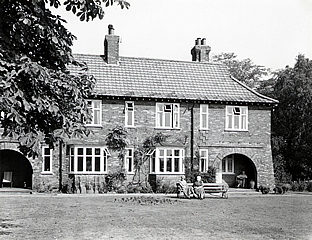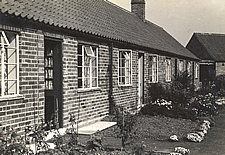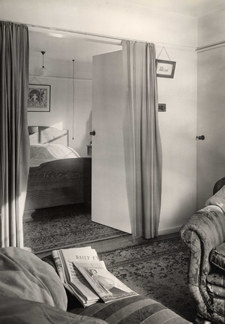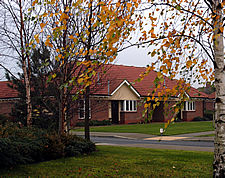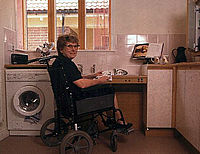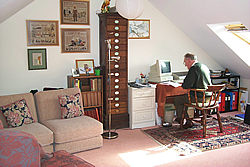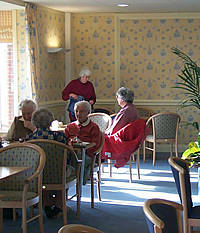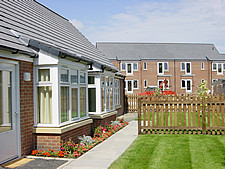Only one-quarter of people born in 1901 can expect to live to retirement, while of those born in 1951 two-thirds will live to retirement age. By 2002 average life expectancy for men is 75, for women nearly 80.
As we live longer, what happens if we need care? Who provides it? How is it managed?
What if we need care?
According to the 1901 Census Report, about a quarter of retired men and half of retired women over 45 live in workhouses or asylums. In 1906, Joseph Rowntree institutes one of the first employee pension schemes for 4,000 workers at his York factory.
Disruption to family life in the Second World War heightens awareness of the needs of older people. In New Earswick, the first buildings opened after the war are designed for older people.
Nationally, the provision of care services continues to grow throughout the century. The 1980s see a move away from the direct provision of services by local authorities. The voluntary sector once again finds itself providing essential welfare services. In 1990, the Community Care Act introduces the 'care package', drawing on a range of services from different sources according to individual need. But for the first time people are required to have individual assessments in order to get state funding. With state support rationed, not everyone gets the assistance they need from statutory services.
Who provides care?
The 2001 Census is the first to ask people if they provide unpaid care for a family member or friend. It finds 5.2 million carers in England and Wales; over a million provide more than 50 hours a week.
Community care aims to help people live independently in their own homes. Assessments indicate whether adaptations to the home can help. The way we plan our homes may meet some of our needs in the future. Lifetime Homes are designed to adapt easily as our circumstances change. Smart homes let technology do some of the hard work for us.
Residential care also changes. In 1946, the Joseph Rowntree Housing Trust builds twelve cottages for older people in New Earswick. The flexible design allows people to remain fully engaged in home life for as long as possible; a retired nurse is on call for emergencies. Four years later, The Garth provides bed-sitting accommodation - later extended to provide bungalows - for older people. In 1984 it is registered as a care home; by the end of the century it is providing accommodation for 23 older people. Over 60 older people are living at Red Lodge in New Earswick. In 2001, The Garth is converted into the JRHT's offices. The Housing Trust continues to expand its provision of care services for people with a variety of different needs, including those with learning difficulties.
In 1998 – after ten years of detailed planning and research – the JRHT opens the UK's first continuing care retirement community in New Earswick. With 152 bungalows, the high quality accommodation and communal facilities at Hartrigg Oaks are intended to support an active, independent retirement. But Hartrigg Oaks also provides extensive care and support services when these are needed, financed by pooling residents' fees. A survey finds these first residents very satisfied with the life offered by Hartrigg Oaks: this could be a model for similar communities elsewhere.
Opening in 2004, Bedford Court is the latest development in the JRHT's care services. This integrated care community near Leeds offers accommodation for older people no longer able to live totally independently.
But, as our population ages, the proportion of care home residents who have dementia is rising. Innovative projects are already identifying new designs for residential care and new ways of consulting with residents with dementia.
How is care managed?
In 1959 an Act of Parliament allows the then Joseph Rowntree Village Trust to undertake research as well as building and managing homes. The Village Trust becomes the Joseph Rowntree Memorial Trust until it is renamed the Joseph Rowntree Foundation in 1990. One of its first acts in the research field is to support the formation of the National Institute for Social Work Training. This support continues for twenty years. But improving social work practice remains a concern over the next forty-five years.
The Foundation can build on practical experience. In 1972 the government asks the Foundation to run the Family Fund, giving grants to severely disabled children and their families. This arrangement lasts until the Family Fund becomes a fully independent charity in 1996. Links with the Foundation continue through research at the Family Fund which provides valuable information on the particular needs of this group.
Drawing on messages from both research and practice, the Foundation develops the JRF Certificate in Care, aimed at increasing the skills and knowledge of professional carers. The first students graduate in 1997. And through its own nursing and residential care homes – as well as work with older people in the community – the Foundation promotes the MDS method of care assessment. This takes into account the physical, emotional and social aspects of a resident's life, forming the basis of comprehensive care plans. Its accurate assessment of residents' needs helps managers plan staffing more effectively and build fairer charging structures.
Both these initiatives reflect the national drive towards involving users in care planning and provision. In the 1990s, an extensive programme of research on putting care into practice offers good practice pointers for day-to-day working. Legislation in 1996 introduces direct payments, advocated by JRF research, allowing disabled people to purchase and manage their own support.
But concerns are growing about the underfunding of residential care. With life expectancy, rising costs and expectations all likely to continue to increase in the years ahead, how will we pay for long-term care?
Find out more about the JRHT's care services, the Foundation's current research priorities, and how it is working to effect change.

